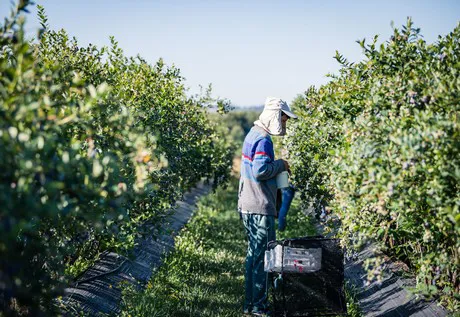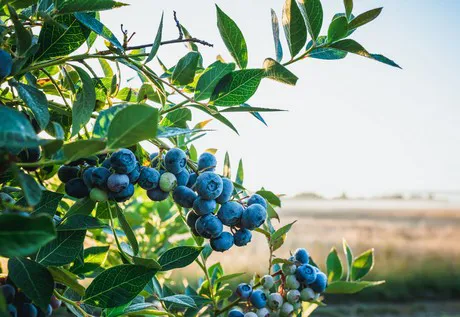Chilean blueberry supplies to North America are hitting their peak this month as volumes remain strong. Growing conditions have been good for the most part, despite a recent warm spell in southern and central regions and total export volumes are expected to be similar to last season. The industry is reporting that global exports from Chile through week 6 are sitting three percent higher than at the same time last year.
"This has shaped up to be a great year for Chilean conventional and organic blueberries in North America and across the globe," noted Karen Brux, Managing Director of the Chilean Fresh Fruit Association. "We’re in the heart of our main promotional period, and blueberries from Chile will be available through March. Chile exported 3,945 tons of fresh blueberries in Week 6, with global exports reaching 98,427 tons for this season. Total volume shipped to the U.S. through Week 6, including both conventional and organic blueberries, is 52,955 tons."

Organic a star performer
Volumes for organic Chilean blueberry exports are seeing a significant increase over last year. Around 80 percent of organic blueberry exports from Chile are destined for North America. It's not just Chilean exports that have increased, but imports into North America have risen by a notable margin as well.
"Organic blueberry exports are at their peak, with 11,785 tons exported season to date, a 41 percent increase over last season," Brux shared. "9,073 tons of fresh organic blueberries from Chile were shipped to the U.S. through Week 6, so that’s 77 percent of total organic volume, and our organic blueberry imports are up 30 percent compared to last season. We expect organic volume to be around 12 or 13 percent of the total fresh blueberry volume shipped to the U.S., but if you look at volume shipped through Week 6, organic is 17 percent of the total!"
Brux added that this presents a great opportunity for organic blueberry promotions, and the Association is working with all facets of the industry in order to help drive this forward. "Organic fresh produce sales hit $5.6 billion in 2018. The exciting part about this for us is that in terms of absolute dollars, blueberries saw the biggest increase, with the organic blueberry category growing by $63.9 million. As the Southern Hemisphere's premier supplier of organic blueberries, this is encouraging news for Chile. We have a long history of working with retailers across the country to promote Chilean blueberries, and we’re now extending that support to organic-specific promotions. We’re committed to expanding the category, so it’s key that we work with retailers to drive sales of both conventional and organic blueberries. As a result, we are increasing our marketing efforts for this growing category. We recently exhibited at GOPEX (Global Organic Produce Expo) in Florida and met with numerous retail chains to discuss organic promotions."

Meeting the challenge of Peru
Peru has been growing its share of blueberry exports over the past few years, experiencing strong volume growth. It has been reported that this past season, Peru's exports grew by 50 percent in dollar value compared to the previous year and is now approaching Chile in terms of overall volume. Chilean exporters are aware of the competition they face and are working even harder to solidify their leading position in the market.
"Peru is certainly a competitor, but the quality of Chilean blueberries, along with the longstanding relationships we’ve built with the trade (whether importers, wholesalers or retailers) have allowed us to maintain a strong position in the market," Brux explained. "We’re focused on sending more of not just the newest, but the best varieties to North America and our markets across the globe. We believe that there are numerous points of differentiation for Chilean blueberries, and we’re in the process of implementing programs that will demonstrate what makes Chilean blueberries unique. We need to bring the story of Chilean blueberries (the orchards, the people, the country, etc.) to life and show what makes Chile the preferred source for fresh blueberries during the winter months."
As part of this, Brux added that the industry is also looking to growth in other markets, which will likely mean an adjustment in dynamics in the future. "North America continues to be Chile’s largest export market for fresh blueberries, but Chile is also developing other markets in Europe and Asia. As those markets grow, North America’s market share will be impacted."

New website
Recently, the Chilean Fresh Fruit Association updated its website. Along with a refreshed look, the Association also enhanced the content, which is all aimed at providing people with more information about all of Chile's fresh fruits, including blueberries.
"We recently revamped/redesigned our website and there is a wealth of information about all Chilean fruits, including blueberries," Brux announced. "The trade can access detailed information on all the fresh fruits Chile exports, and also download point of sale and images to use in their marketing. Consumers can find recipes and usage videos for all eating occasions.
For more information:
Karen Brux
Chilean Fresh Fruit Association
Ph: +1 (650) 654-0777
kbrux@fruitsfromchile.com
www.fruitsfromchile.com
